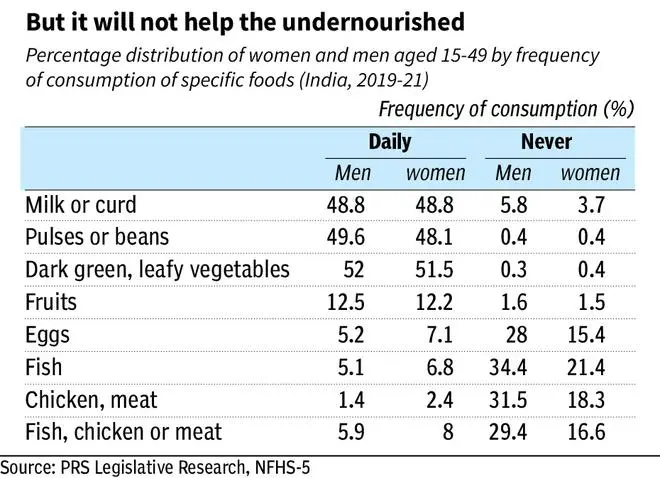During the ongoing election campaign in five States, Prime Minister Narendra Modi made an announcement to extend the free foodgrain scheme to 80 crore individuals for an additional five years. The Pradhan Mantri Garib Kalyan AnnaYojana (PMGKAY), originally set to conclude on December 31, 2023, will now remain operational until December 2028.
As India aims to become a $5-trillion economy by 2025, subsidised/ free food schemes still remain vital to feed over half of its population. The Department of Food and Public Distribution has been allocated a budget of ₹2,05,514 crore for FY24, with food subsidy being the largest expenditure. Approximately 96 per cent of the department’s allocation in 2023-24 is allocated to food subsidy.

Extending the provision of free foodgrains for five more years is expected to result in an extra expenditure of approximately ₹40,000 crore during the current fiscal year, as estimated by economists. .

While basic survival food comes from government schemes, a significant portion of the Indian population still grapples with access to a healthy diet.
This year’s ‘State of Food Security and Nutrition in the World’ report from the Food and Agriculture Organisation (FAO) reveals that 74 per cent of the Indian population cannot afford a nutritious diet.
Data from the National Family Health Survey-5 (NFHS-5) for the years 2019-2021 reveals that in India, 36 per cent of children under the age of five exhibit stunted growth, indicating chronic undernutrition. Nineteen per cent of these children are wasted, signifying acute undernutrition, and 32 per cent are underweight. A small fraction, 3 per cent, are overweight.

The statistics indicate that the prevalence of stunting and underweight children has decreased since 2015-16. Stunting has decreased from 38 per cent in 2015-16 to 36 per cent in 2019-21, while wasting has declined from 21 per cent in 2015-16 to 19 per cent in 2019-21.
The prevalence of undernutrition is nearly identical among girls and boys, although girls exhibit slightly lower nutritional status than boys across all three measures.
Consumption pattern
Experts say that a balanced diet is essential for the well-being of both women and men, ensuring they receive adequate protein, fat, carbohydrates, vitamins, and minerals.
According to NFHS-5, women predominantly include pulses and beans, as well as dark green, leafy vegetables in their diet. Approximately 52 per cent of women consume dark green, leafy vegetables daily, with an additional 39 per cent doing so weekly.
Nearly 50 per cent of women consume pulses or beans daily, while 43 per cent consume them weekly. Milk or curd is part of the daily diet for 49 per cent of women, and 24 per cent include it weekly, though 6 per cent never consume it, and 22 per cent do so only occasionally.
Fruits and non-veg
The consumption of fruits is less frequent, with 49 per cent of women partaking occasionally. Daily consumption of chicken, meat, fish, or eggs is quite low among women, but approximately one-third of them include these foods in their diets weekly.
Men are less likely to be vegetarians than women, with 29 per cent of women and 17 per cent of men practicing vegetarianism.
According to the NHFS-5 data, dietary deficiencies are more common among individuals with little or no formal education, those living in rural areas, those in lower-income households, and those belonging to scheduled tribes. The most notable deficiencies are observed in fruit and milk or curd consumption for both men and women.








Comments
Comments have to be in English, and in full sentences. They cannot be abusive or personal. Please abide by our community guidelines for posting your comments.
We have migrated to a new commenting platform. If you are already a registered user of TheHindu Businessline and logged in, you may continue to engage with our articles. If you do not have an account please register and login to post comments. Users can access their older comments by logging into their accounts on Vuukle.